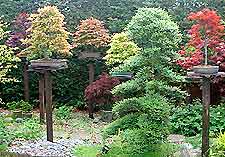Bonsai Trees
Glossary of Terms

Bonsai Glossary:
accent plant - A separate plant or group of plants used to add a subtle element of nature when exhibiting bonsai trees. Small in size, suitable plants include grasses, reeds, herbs, bulbs and many others.
air-layer - Method of propagation, encouraging branches to produce roots whilst still attached to the tree. Achieved by ring barking an individual branch which is then wrapped in sphagnum moss and sealed within a plastic bag. When sufficient roots have grown, the branch is severed to become a new plant.
apex - The top growth or highest point on a tree.
apical bud - A bud at the tip of a shoot.
bleeding - The loss of sap caused by wounding or pruning.
callous - Woody 'scar' tissue that grows over a wound.
candles - The annual new shoots found on pine trees.
canopy - Upper and outermost portion of the trees branches.
chichi - Nodules found on the trunks of old Ginkgo specimens.
companion plant - A separate plant or group of plants used to add a subtle element of nature when exhibiting bonsai trees. Small in size, suitable plants include grasses, reeds, herbs, bulbs and many others.
crown - Upper part of a tree, formed by the trunk and spreading branches.
deciduous - Tree or shrub that sheds its leaves every autumn and develops new foliage in spring.
defoliation - Leaf pruning, whereby some or all of the leaves are removed to encourage new shoots and smaller leaves on deciduous trees.
die-back - The death of shoots or branch tips, caused by drought, insects, disease, lack of light or extreme weather conditions.
dormancy - Resting period for plants, during the winter months, where little or no growth is produced.
dwarf - Variety or cultivar of larger plant, that is smaller, with compact, slow growth. Indicated by Latin name 'nana'.
ericaceous - Describes acidic soil conditions or plant that requires this.
evergreen - Tree or shrub that retains its leaves throughout the year.
fibrous root - Fine roots which absorb water and nutrients from the soil.
ibigawa rock - A type of rock from the Ibigawa region of Japan, with a greyish hue it is often highly fissured and sometimes carved artificially by acid. Ideal for rock plantings.
internode - The length between sets of buds on plant growth.
jin - A branch or apex of a tree that has been stripped of bark, shaped and bleached.
leader - The main shoot at the top of the tree.
lime sulphur - Used to paint jins and deadwood areas to bleach and preserve.
mame - A miniature bonsai, which can be held in the palm of a hand.
mycorrhiza - A beneficial fungus found mainly on conifer roots (most often pines), helping them absorb nutrients.
N.P.K. - Chemical symbols for main elements found in fertilisers - 'N' nitrogen (for foliage), 'P' phosphorus (for roots) and 'K' potassium (for flowers).
nebari - The Japanese term for exposed surface rootage.
needle - A very narrow leaf, often evergreen and usually pointed, being hard in texture, e.g. foliage on pines and spruce.
node - The area of a plant stem where leaves emerge.
petiole - The leaf stalk.
photosynthesis - The process whereby sunlight is absorbed by plant foliage and converted into sugars by combining carbon dioxide and water.
pinching - A technique used to control and shape soft new growth, by carefully pinching or pulling off small shoots by hand.
pinnate - A leaf stem that comprises several 'leaflets' on separate stalks.
raceme - A long flower stem, with many separate flower stalks, e.g. wisteria flowers.
ramification - Dense, compact growth as a result of pruning techniques.
ring-barking - Used in air-layering, a strip of bark is removed from a branch to promote root growth at that selected point.
shari - Bleached, driftwood area of trunk, where bark has been removed.
shohin - A small sized bonsai tree.
stratify - Natural process whereby seeds are exposed to freezing and thawing during winter, encouraging germination. These conditions can also be recreated artificially using a refrigerator or freezer.
suiban - A shallow pot without drainage holes. Used to display individual viewing stones (see suiseki), often being filled with find sand - or for rock plantings, which are usually stood in water.
suiseki - 'Viewing stones' that suggest a mountain scene or landscape, usually displayed in shallow pots or specially carved wooden stands.
systemic - Type of insecticide or fungicide that is absorbed into the system of a plant.
tap root - The main downward growing root of a tree, helping to anchor it firmly in the ground.
tokonoma - An area where individual specimen bonsai are displayed, consisting of three elements, the bonsai tree (man), a scroll (heaven) and an accessory (earth).
transpiration - The natural process of water loss from the surfaces of leaves and plant stems.
tufa rock - A type of soft limestone rock, easily carved and ideal for rock plantings.
uro - A carved or natural trunk recess area, at the point where a branch has been removed.
 Bonsai Glossary: accent plant - A separate plant or group of plants used to add a subtle element of nature when exhibiting bonsai trees. Small in size, suitable plants include grasses, reeds, herbs, bulbs and many others.
Bonsai Glossary: accent plant - A separate plant or group of plants used to add a subtle element of nature when exhibiting bonsai trees. Small in size, suitable plants include grasses, reeds, herbs, bulbs and many others.